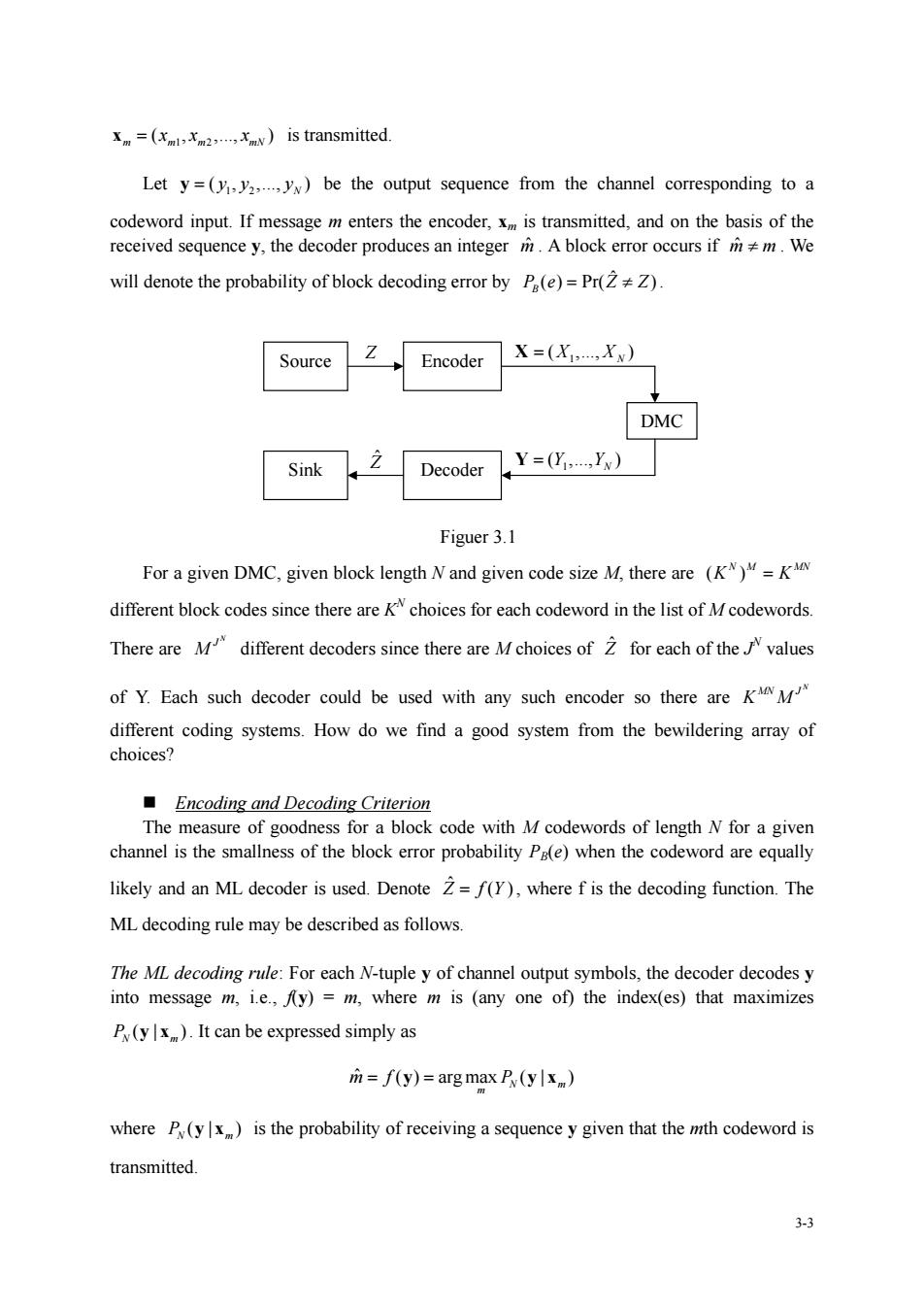正在加载图片...

=(is transmitted. Let y=(.)be the output sequence from the channel corresponding to a codeword input.If message m enters the encoder,is transmitted,and on the basis of the received sequence y,the decoder produces an integer A block error occurs ifm.We will denote the probability of block decoding error by P(e)=Pr(Z). Source Encoder=() DMC Sink Decoder Y=(Y.Yy) Figuer 3.1 For a given DMC,given block length Nand given code size M.there are (K)=K different block codes since there are Kchoices for each codeword in the list of Mcodewords. There areM different decoders since there are Mchoices of for each of thevalues of Y.Each such decoder could be used with any such encoder so there are different coding systems.How do we find a good system from the bewildering array of choices? Encoding and Decoding Criterion measure Tg000 a block code with M codewords of length N for a give channel is the smallness of the block error probability Pa(e)when the codeword are equally likely and an ML decoder is used.Denote Z=f(Y),where f is the decoding function.The ML decoding rule may be described as follows. The ML decoding rule:For each N-tuple y of channel output symbols,the decoder decodesy into message m,i.e.,fy)=m,where m is (any one of)the index(es)that maximizes P(y).It can be expressed simply as =f(y)=argmax P(ylx) where P(yx)is the probability of receiving a sequence y given that the mth codeword is transmitted. 3.3 3-3 1 2 ( , ,., ) m m m mN x = x x x is transmitted. Let 1 2 ( , ,., ) N y = y y y be the output sequence from the channel corresponding to a codeword input. If message m enters the encoder, xm is transmitted, and on the basis of the received sequence y, the decoder produces an integer mˆ . A block error occurs if m m ˆ ≠ . We will denote the probability of block decoding error by ˆ ( ) Pr( ) Pe Z Z B = ≠ . Figuer 3.1 For a given DMC, given block length N and given code size M, there are ( ) N M MN K K= different block codes since there are KN choices for each codeword in the list of M codewords. There are N J M different decoders since there are M choices of Zˆ for each of the J N values of Y. Each such decoder could be used with any such encoder so there are N MN J K M different coding systems. How do we find a good system from the bewildering array of choices? Encoding and Decoding Criterion The measure of goodness for a block code with M codewords of length N for a given channel is the smallness of the block error probability PB(e) when the codeword are equally likely and an ML decoder is used. Denote ˆ Z = f Y( ), where f is the decoding function. The ML decoding rule may be described as follows. The ML decoding rule: For each N-tuple y of channel output symbols, the decoder decodes y into message m, i.e., f(y) = m, where m is (any one of) the index(es) that maximizes (| ) PN m y x . It can be expressed simply as ˆ ( ) arg max ( | ) N m m mf P = = y y x where ( | ) PN m y x is the probability of receiving a sequence y given that the mth codeword is transmitted. Source Encoder DMC Sink Decoder 1 ( ,., ) Z X = X X N 1 ( ,., ) Y = Y YN Zˆ